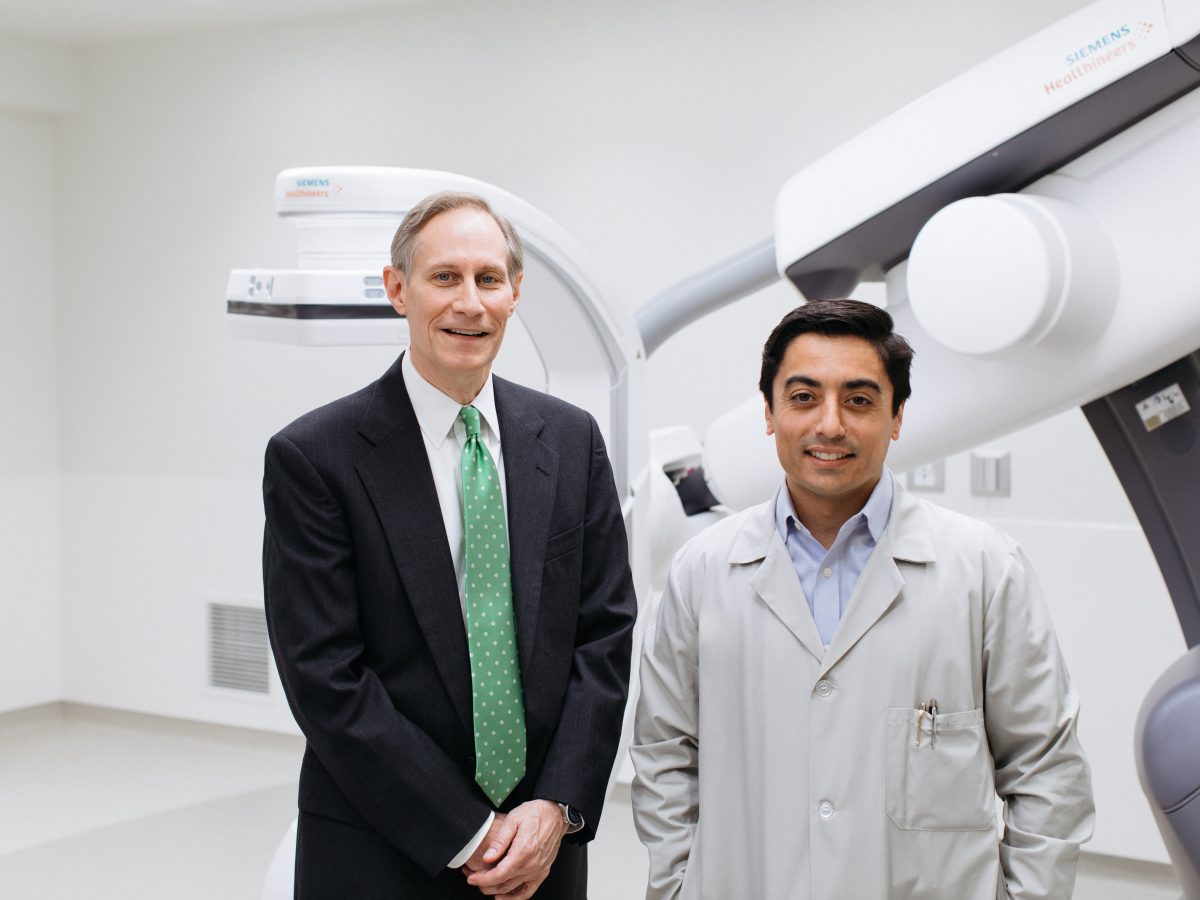Treatments
Even when you are not experiencing symptoms, valve disease is often progressive. Medications can help relieve symptoms and decrease the risk of further problems, but no medication will stop a valve from leaking or open a valve that is too constricted.
Our Center for Heart Valve Disease offers the leading-edge surgical and minimally invasive techniques for complex heart valve procedures inside its sophisticated Hybrid Catheterization Lab/Operating Room Suite.
Hybrid Catheterization Lab
The hybrid suite is a contemporary, cutting-edge treatment room with the high-definition imaging capabilities of a cardiac catheterization (cath) lab and the advanced surgical equipment of a full operating room.
Standard cardiac cath labs have equipment that allows for interventional procedures, but they are generally smaller rooms and lack the sterile environment needed for surgical procedures. Operating rooms are sterile and large, but not ideal for interventional procedures because of equipment limitations. Our suite combines the best of both, seamlessly supporting minimally invasive interventions and open surgical procedures.
The generous floor space and the mechanical components of the suite allow for clinicians from various disciplines to be in the room at the same time, working together to treat the patient. Through this integration, the patient is diagnosed and treated efficiently, and emergencies or complications can be handled quickly in one space without putting patient safety at risk.

Procedures performed in the hybrid suite:
The WATCHMAN™ Procedure
The WATCHMAN is a minimally invasive procedure for patients with atrial fibrillation who cannot tolerate blood thinners. Inserted via a catheter in your leg, the WATCHMAN device closes off the left atrial appendage, a small sac in the left side of your heart where blood clots can form and possibly lead to a stroke.
Transcatheter Aortic Valve Replacement (TAVR)
The TAVR procedure is a less invasive technique for aortic stenosis that does not require open-heart surgery. An artificial valve is guided to your heart via a long tube (catheter) that is inserted through a small incision in your leg. The artificial valve is placed within the diseased valve and takes over the job of regulating blood flow. Because this procedure is less invasive than open-heart surgery, it may lessen your length of stay in the hospital and shorten your recovery time. TAVR procedures are performed in our sophisticated suite by a multidisciplinary team of specialists.
Aortic Balloon Valvuloplasty
Aortic Balloon Valvuloplasty is a nonsurgical procedure to repair stenosis (narrowing) of the aortic valve when a patient is not a candidate for surgery. A small catheter holding an expandable balloon is threaded into the heart and placed into the narrowed valve. The balloon is then expanded to stretch open the valve and improve blood flow.
Mitral Valve Annuloplasty
Mitral Valve Annuloplasty is a surgical procedure to reshape, reinforce or tighten the ring around the heart valve (annulus). During this procedure, a new ring is added to the existing ring to provide reinforcement.
Atrial Septal Defect (ASD) Repair
An ASD repair is a nonsurgical procedure to repair a hole in the septum, which is the muscular wall of the heart that separates the two upper chambers. Using a catheter that is guided to your heart through a vein in your groin, a device is released to seal the hole. Over time, tissue grows over the implant and it becomes part of your heart. After the procedure, you will need to take blood-thinning medication to keep clots from forming on the device.
Patent Foramen Ovale (PFO)
The foramen ovale is a hole in the wall of every human fetus’s heart. This hole allows blood to bypass the fetal lungs, which cannot work until they are exposed to air. When a newborn takes its first breath, the foramen ovale closes and seals completely within a few months. In one of four newborns, this hole doesn’t fully seal and needs repair. The PFO is a minimally invasive procedure in which a closure device is placed via a catheter through the groin and into the heart to seal the hole.
Procedures performed in open surgical operating suites:
Surgical Aortic Valve Replacement (SAVR)
If the heart valve is too damaged to repair with a TAVR procedure, open-heart surgery is necessary to replace the diseased valve with either a mechanical valve or a tissue (bioprosthetic) valve.
Mechanical valves are made of metal and have been designed to last a lifetime. Patients with this type of valve will need to take anticoagulant medication for life to prevent blood clots from forming on the metal. Bioprosthetic valves are made from animal or human tissue and usually last 10 to 20 years. These types of valves don’t require the use of long-term anticoagulant medications.
Mitral Valve Repair or Replacement
Mitral valve repair and replacement are open-heart surgeries to correct either leakage or narrowing of the mitral valve. Both require the use of a heart-lung machine to circulate the body’s blood while the heart is stopped.
In a mitral valve repair, damaged portions of the valve are removed and sewn back together. The valve may be tightened (in cases of leakage) with a ring sewn around its circumference.
If the mitral valve cannot be repaired, it is replaced by removing the defective portion and implanting a new valve made of either animal tissue or metal. Patients who undergo these operations are required to take blood-thinning medication either for a few months (if repaired or replaced with animal tissue) or indefinitely (if replaced with a metal valve).
Ventricular Septal Defect (VSD) Repair
A VSD repair is a nonsurgical procedure to repair a hole in the septum, which is the muscular wall of the heart that separates the two lower chambers. Using a catheter that is guided to your heart through a vein in your groin, a device is released to seal the hole. Over time, tissue grows over the implant and it becomes part of your heart. After the procedure, you will need to take blood-thinning medication to keep clots from forming on the device.